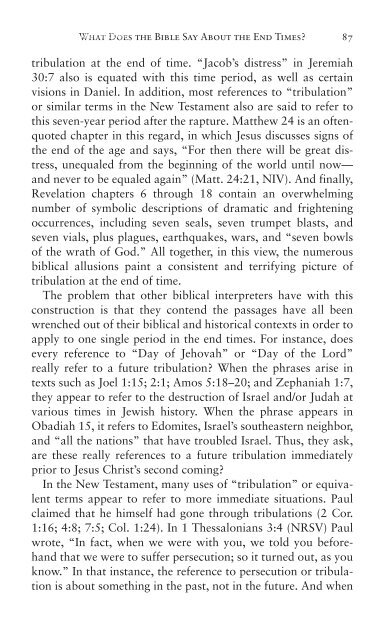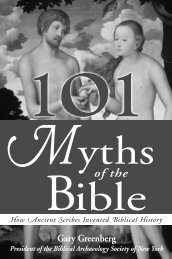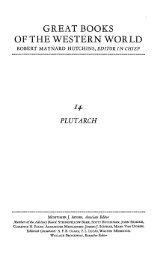Rapture, Revelation, and the End Times - Conscious Evolution TV
Rapture, Revelation, and the End Times - Conscious Evolution TV
Rapture, Revelation, and the End Times - Conscious Evolution TV
Create successful ePaper yourself
Turn your PDF publications into a flip-book with our unique Google optimized e-Paper software.
What robin-bobin Does <strong>the</strong> Bible Say About <strong>the</strong> <strong>End</strong> <strong>Times</strong>? 87tribulation at <strong>the</strong> end of time. “Jacob’s distress” in Jeremiah30:7 also is equated with this time period, as well as certainvisions in Daniel. In addition, most references to “tribulation”or similar terms in <strong>the</strong> New Testament also are said to refer tothis seven-year period after <strong>the</strong> rapture. Mat<strong>the</strong>w 24 is an oftenquotedchapter in this regard, in which Jesus discusses signs of<strong>the</strong> end of <strong>the</strong> age <strong>and</strong> says, “For <strong>the</strong>n <strong>the</strong>re will be great distress,unequaled from <strong>the</strong> beginning of <strong>the</strong> world until now—<strong>and</strong> never to be equaled again” (Matt. 24:21, NIV). And finally,<strong>Revelation</strong> chapters 6 through 18 contain an overwhelmingnumber of symbolic descriptions of dramatic <strong>and</strong> frighteningoccurrences, including seven seals, seven trumpet blasts, <strong>and</strong>seven vials, plus plagues, earthquakes, wars, <strong>and</strong> “seven bowlsof <strong>the</strong> wrath of God.” All toge<strong>the</strong>r, in this view, <strong>the</strong> numerousbiblical allusions paint a consistent <strong>and</strong> terrifying picture oftribulation at <strong>the</strong> end of time.The problem that o<strong>the</strong>r biblical interpreters have with thisconstruction is that <strong>the</strong>y contend <strong>the</strong> passages have all beenwrenched out of <strong>the</strong>ir biblical <strong>and</strong> historical contexts in order toapply to one single period in <strong>the</strong> end times. For instance, doesevery reference to “Day of Jehovah” or “Day of <strong>the</strong> Lord”really refer to a future tribulation? When <strong>the</strong> phrases arise intexts such as Joel 1:15; 2:1; Amos 5:18–20; <strong>and</strong> Zephaniah 1:7,<strong>the</strong>y appear to refer to <strong>the</strong> destruction of Israel <strong>and</strong>/or Judah atvarious times in Jewish history. When <strong>the</strong> phrase appears inObadiah 15, it refers to Edomites, Israel’s sou<strong>the</strong>astern neighbor,<strong>and</strong> “all <strong>the</strong> nations” that have troubled Israel. Thus, <strong>the</strong>y ask,are <strong>the</strong>se really references to a future tribulation immediatelyprior to Jesus Christ’s second coming?In <strong>the</strong> New Testament, many uses of “tribulation” or equivalentterms appear to refer to more immediate situations. Paulclaimed that he himself had gone through tribulations (2 Cor.1:16; 4:8; 7:5; Col. 1:24). In 1 Thessalonians 3:4 (NRSV) Paulwrote, “In fact, when we were with you, we told you beforeh<strong>and</strong>that we were to suffer persecution; so it turned out, as youknow.” In that instance, <strong>the</strong> reference to persecution or tribulationis about something in <strong>the</strong> past, not in <strong>the</strong> future. And whenrobin-bobin





